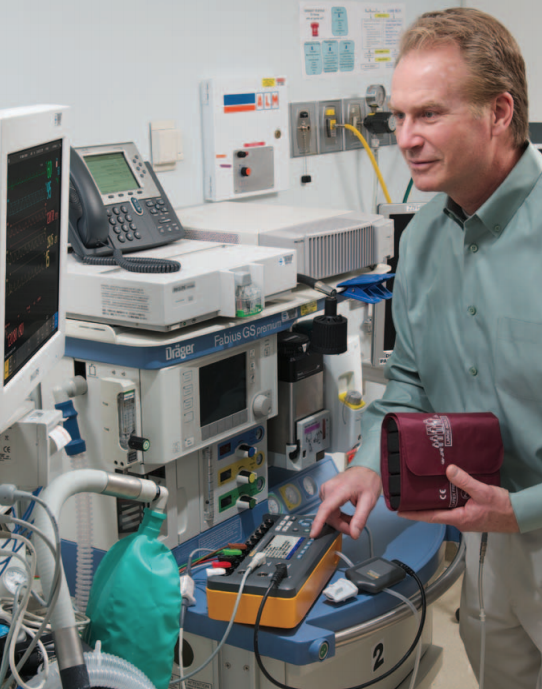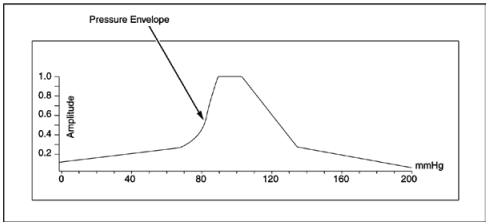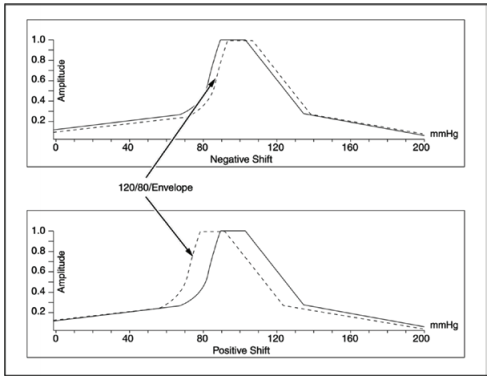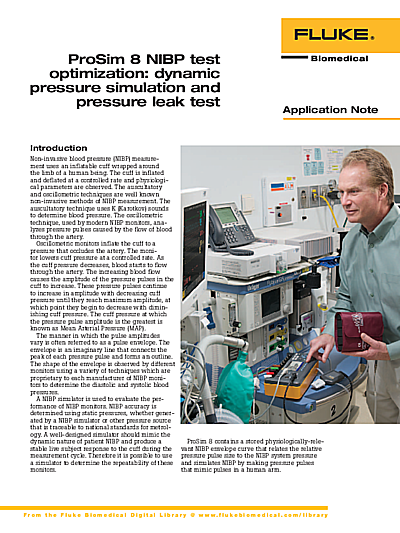Prosim 8 App Note: ProSim 8 NIBP test optimization: dynamic pressure simulation and pressure leak test
Introduction Non-invasive blood pressure (NIBP) measurement uses an inflatable cuff wrapped around the limb of a human being. The cuff is inflated and deflated at a controlled rate and physiological parameters are observed. The auscultatory and oscillometric techniques are well known non-invasive methods of NIBP measurement. The auscultatory technique uses K (Karotkov) sounds to determine blood pressure. The oscillometric technique, used by modern NIBP monitors, analyzes pressure pulses caused by the flow of blood through the artery. Oscillometric monitors inflate the cuff to a pressure that occludes the artery.
The monitor lowers cuff pressure at a controlled rate. As the cuff pressure decreases, blood starts to flow through the artery. The increasing blood flow causes the amplitude of the pressure pulses in the cuff to increase. These pressure pulses continue to increase in amplitude with decreasing cuff pressure until they reach maximum amplitude, at which point they begin to decrease with diminishing cuff pressure. The cuff pressure at which the pressure pulse amplitude is the greatest is known as Mean Arterial Pressure (MAP).
The manner in which the pulse amplitudes vary is often referred to as a pulse envelope. The envelope is an imaginary line that connects the peak of each pressure pulse and forms an outline. The shape of the envelope is observed by different monitors using a variety of techniques which are proprietary to each manufacturer of NIBP monitors to determine the diastolic and systolic blood pressures.
A NIBP simulator is used to evaluate the performance of NIBP monitors. NIBP accuracy is determined using static pressures, whether generated by a NIBP simulator or other pressure source that is traceable to national standards for metrology. A well-designed simulator should mimic the dynamic nature of patient NIBP and produce a stable live subject response to the cuff during the measurement cycle. Therefore it is possible to use a simulator to determine the repeatability of these monitors.

ProSim 8 contains a stored physiologically-relevant NIBP envelope curve that relates the relative pressure pulse size to the NIBP system pressure and simulates NIBP by making pressure pulses that mimic pulses in a human arm.
How to adjust NIBP pulse envelope in ProSim 8
To modify the shift of the blood pressure envelope in ProSim 8 with firmware 2.00:
- From the NIBP sub menu, highlight ENVELOPE SHIFT, then select ENTER
- Use the up and down buttons to shift the entire blood pressure envelope to the left (“–” shift) or right (“+”shift). The default value for a shift is zero, and the range is from –10 % to +10 %. The graphs below illustrate a blood pressure envelope with no shift, a negative shift, and a positive shift respectively.
The table below compares 120/80 mmHg NIBP test results with positive and negative envelope shifts versus no envelope shift (0 %) on some popular monitors in the market.
Envelope shift helped bridge readings on some monitors such as SpaceLabs and Philips to the simulated values. We have noticed testing results may vary not only among different monitors that use a proprietary pulse envelope to calculate the diastolic and systolic blood pressures, but also among different monitors from the same manufacturer. Keep in mind, repeatability determines the dynamic NIBP measurement performance of a patient monitor, and a simulator is used to determine the dynamic blood pressures repeatability rather than the accuracy of patient monitors. ProSim 8 generates a very repeatable signal within ± 2 mmHg.



Recommended pressure leak test procedure from OIML R 16-2 standard
The leak test measures leaks in a non-invasive blood pressure monitor. Put the NIBP monitor in “calibrate” or “service” mode to close the vent valve so the ProSim 8 can inflate the pneumatic system. Refer to the service manual for the specific NIBP monitor on how to initiate the “calibrate” or “service” mode.
The following is the recommended pressure leak testing procedure from International Organization of Legal Metrology about NIBP test standard (OIML R 16-2, Edition 2002)
Apparatus
- Rigid metal vessel with a capacity of 500 ml ± 5 %
- Reference manometer or simulator
- Pressure generator (ball pump/hand pump)
- T-piece connectors and hoses
Procedure
- Replace the cuff with the rigid vessel. Connect the reference manometer and pump by means of a T-piece connector and hoses to the pneumatic circuit (see figure above; please note ProSim 8 can replace both items 1 and 4 in the figure.)
- Carry out the test over the entire measuring range at five equally-spaced pressure steps (at least, 50, 100, 150, 200 and 250 mmHg)
- Test the air leakage rate over a period of 5 minutes and determine the measured value from this.
- Because the thermodynamic equilibrium is influenced by decreasing or increasing the pressure when changing to the next pressure step, wait at least 60 seconds before reading the values.
- Express the air leakage as the rate of pressure loss per minute. Most monitor manufacturers recommend the leak rate should be less than 8 mmHg/min.

